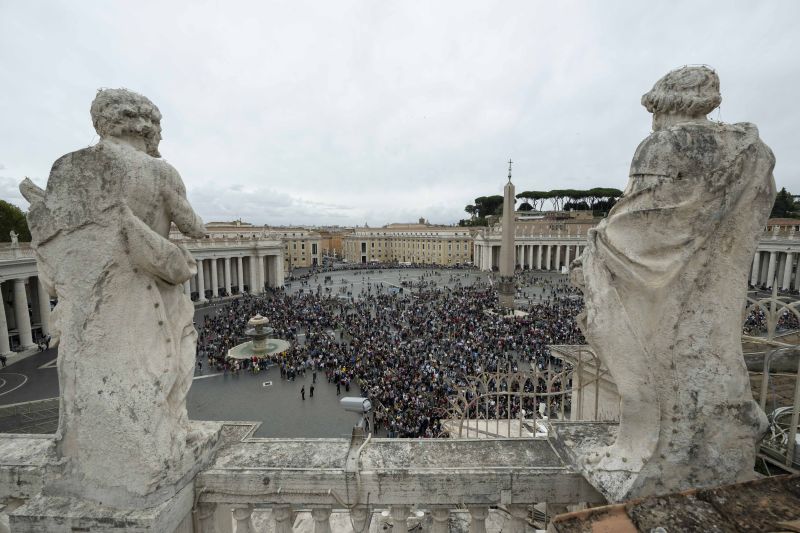 Pilgrims gather in St. Peter’s Square for the Angelus on the Solemnity of All Saints, Nov. 1, 2023. / Credit: Vatican Media
Pilgrims gather in St. Peter’s Square for the Angelus on the Solemnity of All Saints, Nov. 1, 2023. / Credit: Vatican Media
ACI Prensa Staff, Feb 21, 2024 / 04:00 am (CNA).
In times when the truth offends and Christian principles and values seem diluted or relativized, it is worth remembering the great doctor of the Church St. Peter Damian, whom the Church remembers every Feb. 21.
Peter Damian (1007–1072) initially lived as a Benedictine monk but, sensitive to the needs of his time, accepted to be ordained bishop and then a cardinal. He made a very important contribution to the ecclesial renewal of the 11th century, which had its high point in the Gregorian reform.
Prayer and discernment
Peter Damian was a man of deep prayer and recollection. Precisely because of this, he knew how to distinguish what is essential to attain the perfection of charity. The reformist impulse that characterized him throughout his life sprang from an authentic interior life and from assiduous contact with God and with his own inner self.
This saint was well aware that in order to follow Christ it is necessary to form and strengthen the soul, particularly the mind. This is how he himself expresses it beautifully: “May hope raise your joy, may charity kindle your fervor. Thus your mind, well satiated, will be able to forget exterior sufferings and will progress in the possession of the goods it contemplates within itself.”
‘Damiani’
The saint was born in 1007 in Ravenna, Italy. He lost his parents while very young and was left in the care of one of his brothers who did not treat him well. However, to his good fortune, another of his brothers, archpriest of Ravenna, took pity on him and took charge of his education. At his side, Peter felt like a son, which is why he decided to take this brother’s name: “Damiani” (Damian).
As Peter grew up, he showed an increasing inclination to prayer, meditation, and fasting while at the same time being generous with those whom God loved the most — the poor. The saint shared his food with those who were hungry, whom he used to welcome into his home.
Food of the soul, strength of the mind
Peter Damian’s spiritual journey began with the Benedictines. Enthused by the reform of St. Romuald (951–1027), he became a monk in the monastery of Fonte Avellana. Moved by a very great fervor, Peter devoted himself to the practice of the harshest disciplines and rigors. He wore sackcloth, fed himself with only bread and water, and flagellated himself; however, his body could not endure for long and became noticeably weakened. This forced him to moderate himself.
The monk thus understood that these practices alone do not guarantee virtue and that in most cases being patient can be the best penance; all the more so in the midst of the sorrows of this life, which God allows to teach us.
Reformer of the monastic life
On the death of the abbot of the monastery of Fonte Avellana, Peter took over as prior. His desire to strengthen and improve the life of the monks was concretized in reforms that yielded good results.
He founded five more communities of Benedictine hermits while encouraging the monks to always seek the spirit of silence, charity, and humility. St. Dominic Loricato and St. John of Lodi, his disciples, are sons of those reforms.
In 1057 Peter Damian was created cardinal and bishop of Ostia, renouncing what pleased him most: his life in silence and solitude.
His good name became known to all, and he considerably increased the contact he already had with the Roman Curia, and even with the pope. He wrote numerous letters criticizing “simony” — the purchase of spiritual goods as if they were material goods, which included ecclesiastical offices, performance of sacraments, sacramentals, the trade of relics, and promises of prayer.
He wrote the so-called Book of Gomorrah (a title alluding to the Old Testament city of Gomorrah) and spoke out strongly against the impure customs of his time. He also wrote about the duties of clerics and monks, to whom he recommended spiritual discipline rather than prolonged fasting.
The future of the Church
“It is impossible to restore discipline once it has fallen into decay; if we, through negligence, allow the rules to fall into disuse, future generations will not be able to return to the primitive observance. Let us guard against incurring such a fault, and let us faithfully transmit to our successors the legacy of our predecessors,” the saint wrote sharply, concerned about the responsibility we have toward future generations of Christians.
A curious fact about St. Peter Damian: In his spare time, he used to make wooden spoons and other utensils for his brothers in the faith.
The final episode
Pope Alexander II sent Peter Damian to solve a problem in Ravenna, where the archbishop had declared himself in open rebellion and had incurred excommunication. Unfortunately, the saint arrived after the prelate had died, but such was his example of justice and charity in fraternal correction that the accomplices of the rebel recognized their error, assumed their penance, and reformed their conduct.
On his way back to Rome, Peter Damian fell ill during his stay in a monastery on the outskirts of Faenza and died there on Feb. 22, 1072.
Dante Alighieri, author of The Divine Comedy, in the XXI canto of “Paradise,” places St. Peter Damian in the heaven of Saturn, destined for high contemplative spirits. He was declared a doctor of the Church in 1828 by Pope Leo XII.
This article was originally published by ACI Prensa, CNA’s Spanish-language news partner, and has been translated and adapted by CNA.
[…]






